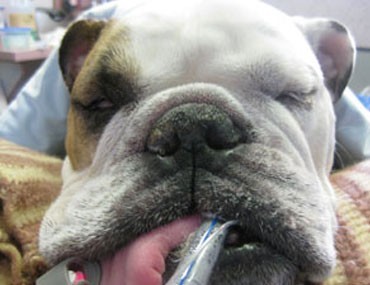
Dr. Phil Zeltzman is a mobile, board-certified surgeon in Allentown, PA. Find him online at www.DrPhilZeltzman.com. He is the co-author of “Walk a Hound, Lose a Pound” (www.WalkaHound.com).
Kelly Serfas, a Certified Veterinary Technician in Bethlehem, PA, contributed to this article.
The Dangers
Whether because of a bad personal experience with another pet, or lack of information, many pet owners are scared of having their pets put under anesthesia. Surely, there’s always a risk with anesthesia, for any pet. As the saying goes, there are routine surgeries, but there is no routine anesthesia. Fortunately, veterinary anesthesia has become very safe thanks to better protocols, safer drugs and sophisticated monitoring.
The Facts
A scientific study led by Dr. Brodbelt, a British, board-certified anesthesiologist, showed that the death rate under sedation or anesthesia is around 0.15% on average. Meaning 99.85% of patients survive anesthesia and sedation, clearly an overwhelming majority. The research is exceptional as 98,000 dogs participated, an unusually large sample for a veterinary study. Anesthesia lasted for an average of one hour, for a variety of procedures performed by general practitioners as well as specialists. Patients were 8 years old on average.
Patients fell into three categories: healthy, ill or very sick. Anesthesia risks were slightly higher with:
• Sick patients (up to 7 times more risk)
• Emergency anesthesia (up to 3 times more risk)
• More involved surgeries (up to 5 times more risk)
• Older patients (up to 7 times more risk for patients over 12 years of age)
• Small patients (up to 8 times more risk for patients under 10 pounds)
• Use of halothane anesthesia gas (up to 8 times more risk compared to isoflurane)
• Brachycephalic breeds (dogs with a flat face, such as Bulldogs and pugs)
The study also revealed that most patients die after anesthesia, and not during anesthesia. The study considers a death to be related to anesthesia when it occurs within the following 48 hours, and especially when it is within the first 3 hours. In fact, over half of the deaths occurred within 3 hours of recovering from anesthesia.
 Take Away Points
Take Away Points
This should lead you, as your pet’s best advocate, to talk openly with your family vet, no matter how uncomfortable it may seem. How will your pet be monitored during anesthesia? How will your pet be recovered from anesthesia? Who will do that? Where will your pet be recovered, and how, and by whom?
Ideally, pets should be recovered from anesthesia in a specifically-designated area, away from boarding, barking or sick animals. This provides a quiet, relaxing environment. Also ask what will be done to keep your pet warm during and after surgery. (Is It Cold In Here, Or Did Your Pet Just Have Surgery?)
If, in spite of it all, you’re still concerned about your pet’s recovery, and (s)he needs to stay overnight with no supervision, you may want to consider transferring him or her to a referral hospital that provides medical care overnight. Sure, transportation may be annoying, but you will achieve peace of mind, knowing that your best friend is being pamperedand spoiled all night.
If you have any questions or concerns, you should always visit or call your veterinarian – they are your best resource to ensure the health and well-being of your pets.
